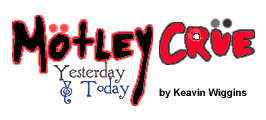
Mötley Crüe, what a story to tell. It’s
about a group of misfits that literally took “sex, drugs and rock n roll”
to heart and became the ultimate party band of the 80’s. Even when the
decade wound down and the genre of music that the Crüe helped to champion
became passé the members of this notorious band continued to make
headlines in every way possible.
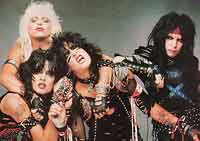 In many ways Mötley Crüe epitomize the excesses of rock n roll and stardom.
Their autobiography, “The Dirt” reads like a Jackie Collins novel but not
even Collins could come up with the outrageous story that is the history
of Mötley Crüe.
In many ways Mötley Crüe epitomize the excesses of rock n roll and stardom.
Their autobiography, “The Dirt” reads like a Jackie Collins novel but not
even Collins could come up with the outrageous story that is the history
of Mötley Crüe.
This brief look at their history is just
that a brief look. If you really want to get the lowdown on the band’s
history then “The Dirt” is a must read. Even if the music isn’t you’re
thing, the book is a great adventure into the rock n roll lifestyle with
all the ups and downs (not just in bed) of stardom and the decadence that
was and continues to be Mötley Crüe.
Even now, over 20 years later, the story
of the Crüe still continues to evolve. With the recent reissue of the entire
Mötley album catalog courtesy of their new record label, Universal/Hip-O
Records, and DVD releases, I thought this would be a great time to take
a quick look at the Mötley story.
The Quick and
Dirty History of Mötley Crüe
In the Beginning…
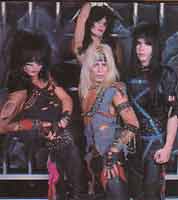 While the baby boomers love to lament about the Height / Ashbury scene
in San Francisco during the summer of love and the Swinging London of the
60’s, the children of the 80’s made the Sunset Strip in Hollywood their
stomping ground and created a music and social scene that was felt around
the world with the emergence of the bands that made their mark first on
the Strip and then world wide in stadiums, arenas and MTV.
While the baby boomers love to lament about the Height / Ashbury scene
in San Francisco during the summer of love and the Swinging London of the
60’s, the children of the 80’s made the Sunset Strip in Hollywood their
stomping ground and created a music and social scene that was felt around
the world with the emergence of the bands that made their mark first on
the Strip and then world wide in stadiums, arenas and MTV.
There is nothing quite like it today. For
a span of a few years, The Strip was the place to be if you were young
and wanted to party or land that big record deal. Sure the fame of the
Strip dates back to the days of the Doors in the 60’s and in the 70’s Led
Zeppelin used to hold court at the Rainbow and turned the Continental Hyatt
House into the “Riot House”. But in the 80’s things were kicked up a few
gears and the Strip was buzzing with activity that you didn't want to miss
out on.
It was during that brief period of time
just after Disco died, and punk never really caught on to the masses in
America as expected, that a group of misfits could band together and change
popular culture and music. Starry-eyed kids with dreams of sex, drugs and
rock n roll stardom flooded the Strip. They injected the hard rock of the
70’s with the energy of punk and for fashion they latched to aspects of
the glitter rock movement and the outlaw biker gangs.
The music wasn’t the prog-rock of the 70’s
that hardcore rock fans tuned in to their FM radios to listen to. It wasn’t
the new wave that the new music outlet MTV was helping sell that seemed
to be more about fashion than the music. The music that came from the bands
on the Strip in the early 80’s was really pop rock given a gutter level
rock n roll make over. Like new wave, fashion and lifestyle played a big
part in the scene.
It was against this backdrop that a misfit
named Nikki Sixx found his rock n roll salvation. By 1981, Nikki was already
an established personality on the Strip. He was often seen at the Starwood
“hangin out", decked out in his Hollywood Vampire attire with a jet black
ball of hair hanging over his eyes.
 When he wasn’t hanging out, he was playing with his band London. A band
that Nikki refers to as Mötley Crüe before Mötley Crüe. The band’s raunchy
rock and flamboyant looks made them a hit on the Strip but the band fizzled
out and Nikki set out to create his own band.
When he wasn’t hanging out, he was playing with his band London. A band
that Nikki refers to as Mötley Crüe before Mötley Crüe. The band’s raunchy
rock and flamboyant looks made them a hit on the Strip but the band fizzled
out and Nikki set out to create his own band.
While watching a band called Suite 19 at
the Starwood one night, Nikki was impressed with the group’s drummer,
a young kid who not only hit the skins hard but did it with showmanship.
His name was Tommy Lee.
The two soon joined up and decided to put
a band together. With a solid rhythm section in place they needed a frontline.
They filled the slots but the players weren’t quite what they were after,
so Tommy spotted an ad in a local music paper advertising a loud, rude
and aggressive guitarists looking for a gig and called the guy up. When
Mick Mars jammed with Tommy and Nikki the chemistry seemed right but Mick
wasn’t impressed with the guitarist who was playing with them. Nikki and
Tommy wanted Mick in the group so the other guy was out and Mick was in.
 Mick also didn’t like the singer of the group and told his bandmates, “I
want that skinny blond f***er I saw at the Starwood the other night in
that band Rock Candy.” Mick wasn’t so much impressed with the singers
musical talent as he was with how he captivated a crowd. Tommy knew exactly
who he was talking about, a young blond singer going by the name of Vince
Neil. A guy he has gone to high school with.
Mick also didn’t like the singer of the group and told his bandmates, “I
want that skinny blond f***er I saw at the Starwood the other night in
that band Rock Candy.” Mick wasn’t so much impressed with the singers
musical talent as he was with how he captivated a crowd. Tommy knew exactly
who he was talking about, a young blond singer going by the name of Vince
Neil. A guy he has gone to high school with.
Tommy tracked down Vince and tried to convince
him to join his new band. Vince pretended to be interested and with a promise
to check it out he blew Tommy off. A short time later Tommy approached
Vince again telling him that he had to check out this new band. Vince relented
and agreed to audition for the band after his group had suddenly imploded.
Vince joked years later, “They got me when I was weak.” But the four
seemed to gel well together and Mötley Crüe was born.
Toast of the Town:
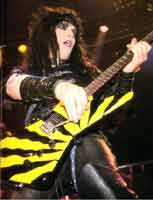 In “The Dirt” Vince described the band as more of a gang than a group,
their wild antics on and off stage quickly helped them build an audience
on the strip and they soon came to the attention of a Northern California
building contractor named Allan Coffman.
In “The Dirt” Vince described the band as more of a gang than a group,
their wild antics on and off stage quickly helped them build an audience
on the strip and they soon came to the attention of a Northern California
building contractor named Allan Coffman.
Wanting to break into the music business,
Coffman convinced the band to sign a 10 year management contract and he
shipped the Crüe up to Northern California to practice and get their act
together. They returned to Hollywood a short time later, ready to take
over the town. Coffman rented a decrepit house a few footsteps away
from the Whiskey for Nikki, Vince and Tommy to live so they would be close
to the action. The parties that followed in what became known as “The Motley
House” are now legendary in the lore of the Strip.
They took to the clubs when they weren’t
hosting after hours parties at home. When they weren’t playing venues like
the Starwood and Whiskey, they were out hanging out, being seen and plastering
every available surface with poster and flyers promoting their shows.
Try as they might to land a deal, the record
companies wouldn’t take a chance on the band. After all “rock was dead”
and “you can’t reinvent KISS”. The head honchos and A&R guys at the
labels were concentrating on New Wave acts and to them a rowdy metal band
with a punk attitude was the last thing they thought would sell records.
So they were left to their own devices and they knew there was something
going on because they were packing the clubs whenever they played. So Hoffman
put up the money and Mötley recorded an album in three days and released
it on their own label. Hoffman got a small distribution company,
Greenworld, behind the record and it became an instant “indy” hit, selling
20,000 copies.
Too Fast For Love
If Tom Zutaut hadn’t been hungry on that
Thursday night, then Mötley Crüe may never had become superstars.
Zutaut was driving down Sunset Blvd, heading towards a café to grab
a bite to eat when he saw a swarm of kids outside of the Whiskey trying
to get in. He looked at the marquee that said “Mötley Crüe Sold Out” and
that got his curiosity going. He pulled over and then bluffed his
way into the show and was amazed by what he saw. The kids ate up every
insane moment of the Mötley show and Tom was sure he had spotted the makings
of a hit rock band.
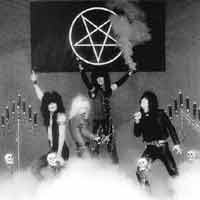 Tom wasn’t a heavy weight in the music industry by any means; he was an
assistant in the Elektra sales department who was just barely out of his
teens. But he did have something special, an ear or rather an eye for promising
young bands. Before discovering Mötley Crüe he had tried to turn the A&R
department at Elektra on to Joan Jett’s “I Love Rock N’ Roll”, Softcell’s
“Tainted Love” and a young group of female rockers known as “The Go-Go’s”.
The A&R department at Elektra wouldn’t listen.
Tom wasn’t a heavy weight in the music industry by any means; he was an
assistant in the Elektra sales department who was just barely out of his
teens. But he did have something special, an ear or rather an eye for promising
young bands. Before discovering Mötley Crüe he had tried to turn the A&R
department at Elektra on to Joan Jett’s “I Love Rock N’ Roll”, Softcell’s
“Tainted Love” and a young group of female rockers known as “The Go-Go’s”.
The A&R department at Elektra wouldn’t listen.
When he tried to pitch Mötley Crüe to Elektra’s
A&R staff, he was ignored. So he put together his previous rejection
letters from the A&R staff where they turned down what later became
hit groups or records and went straight to the top and made a plea to the
chairman of the label, Joe Smith. As Tom remembers it years later,
Smith rose to the challenge and said “ok wise guy, you think you can do
this? Fine. Then let’s sign this band and see how good you really are.”
Elektra took the band’s self-released debut
album, “Too Fast For Love,” and gave it to legendary producer Roy Thomas
Baker to rework. When the reworked album hit the stores through Elektra,
the label gave it practically little backing. Perhaps peeved at Zutaut
for going over their heads, the rest of the label wanted little to do with
Mötley Crüe but the music broke out on its own and the record ended up
selling over a 100,000 copies by word of mouth.
The band landed their first big tour opening
for KISS but that was short lived as Gene and Paul weren't hip to the insane
behavior of this wild band of misfits. The antics of the Crüe began to
take on a life of their own right from the start and they would spend the
next decade smashing their name into the rock n roll history books as one
of the wildest bands that ever took the stage or rampaged a hotel while
on tour. Girls, drugs, more girls and more drugs and alcohol fueled the
Mötley machine of destruction and the more popular they became, the more
they had to live up to their reputation.
Continue
Historic
photos from Myuseless-info.com
All Rights Reserved by Copyright Holders.
|

